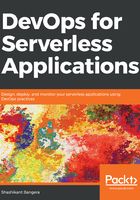
Function as a Service
As mentioned at the start of chapter, FaaS is essentially a small program or function that performs small tasks that are triggered by an event, unlike a monolithic app, which does lots of things. So, in FaaS architecture, we break our app into small, self-contained programs or functions instead of the monolithic app that runs on PaaS and performs multiple functions. For instance, each endpoint in the API could be a separate function, and we can run these functions on demand rather than running the app full time.
The common approach would be to have an API coded in a multi-layer architecture, something like a three-tier architecture where code is broken down into a presentation, business, and data layer. All the routes would trigger the same handler functions in the business layer, and data would be processed and sent to the data layer, which would be a database or file. The following diagram shows this three-tier architecture:

That might work fine for small numbers of simultaneous users, but how would we manage this when traffic grows exponentially? The application will suddenly become a computing nightmare. So, to resolve this problem, ideally, we would separate the data layer, which contains the database, into the separate server. But the problem is still not solved, because the API routes and business logic is within one application, so the scaling would still be a problem.
A serverless approach to the same problem is painless. Instead of having one server for application API endpoints and business logic, each part of the application is broken down into independent, auto-scalable functions. The developer writes a function, and the serverless provider wraps the function into a container that can be monitored, cloned, and distributed on any number of servers, as shown in the following diagram:

The benefit to breaking down an application into functions is that we can scale and deploy each function separately. For instance, if one endpoint in our API is where 90 percent of our traffic goes, or our image-processing code is eating up most of the computing time, that one function or bit code can be distributed and scaled more easily than scaling out the entire application.
In a FaaS system, the functions are expected to start within milliseconds in order to allow the handling of individual requests. In PaaS systems, by contrast, there is typically an application thread that keeps running for long periods of time, and handles multiple requests. FaaS services are charged per execution time of the function, whilst PaaS services charge per running time of the thread in which the server application is running.
In the microservices architecture, the applications are loosely coupled, fine grained, and light weighted. The reason for the birth of microservices is to break down the monolithic application into small services so that it can be developed, managed, and scaled independently. But FaaS takes that a step further by breaking things down into even smaller units called functions.
The trend is pretty clear: The unit of work is getting smaller and smaller. We'are moving from monoliths to microservices, and now to functions, as shown in the following diagram:

With the rise of containers, many cloud vendors saw that serverless functions architecture will provide better flexibility for developers to build their applications without worrying about the ops (operations). AWS was first to launch this service with the name Lambda, then other cloud providers followed the trend, such as Microsoft Azure with Azure Functions and Google Cloud with Google Functions. But this popularity also gave an opportunity for some vendors to build open source versions. Some popular versions are IBM's OpenWhisk, which is Apache licensed, Kubeless, which is built over the top of Kubernetes, and OpenFaaS, which is built over the Docker container. Even Oracle jumped into the foray with Oracle Fn. Let's briefly look at each vendor in this chapter, learning about how they work. We will then travel with them over the rest of the book, looking at their approach to DevOps.